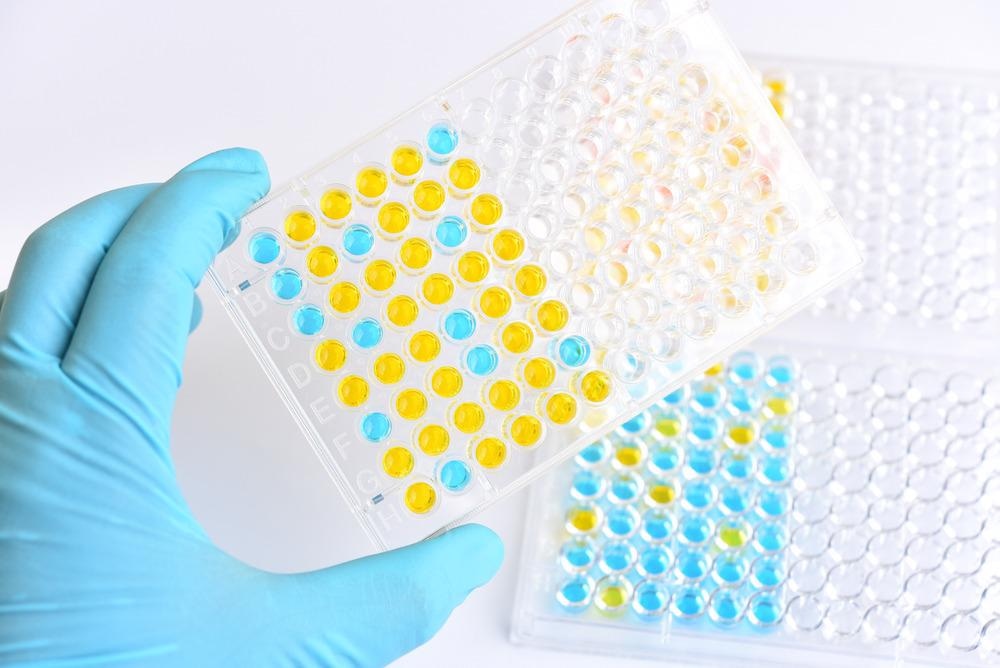A group of researchers utilized magnetic nanorobots (MNRs) as movable immunoassay sensors to allow an approach for automatic and extremely effective ELISA analysis, in an article published in the journal ACS Nano.

Study: Magnetic Nanorobots as Maneuverable Immunoassay Probes for Automated and Efficient Enzyme Linked Immunosorbent Assay. Image Credit: Jarun Ontakrai/shutterstock.com
To produce MNRs, self-assembled strands of iron oxide magnetic particles are thermally coated with a thin layer of refractory silica, which is then bonded with primary antibodies to make magnetically maneuverable immunoassay probes. The team used numerical modeling to explore the vorticity pattern around the MNRs at the microscopic level and experimentally determine the blending effectiveness of the actively spinning MNRs.
Enzyme-linked Immunosorbent Assay (ELISA)
The enzyme-linked immunoassay (ELISA) is a traditional but influential biochemical sensing technique for measuring extremely low analytes using synthetic colorimetry premised on biochemical reactions. Health assessment, ecological investigation, and product safety are just a few of the sectors where ELISA is used.
Drawbacks of Conventional ELISA
Because all stages are performed in a homogeneous cell, repeated washings are required between them to eliminate unattached leftover chemicals and transiently reacting molecules, which is time-consuming.
Another downside of ELISA is that each manual operation has the risk of introducing additional defects. Furthermore, to achieve adequate antibody/antigen, interaction facilitated transport of analytes necessitates extensive incubation durations, limiting efficiency in terms of time and personnel input.
Bio-Sensing Applications of Micro/Nanomotors (MNM)
Micro/nanomotors (MNMs) are miniature nanomaterials that transform energy into a mechanical force for flexion and extension.
Environmental cleanup, microsurgery, biomedical monitoring, freight transport, bioengineering, target capture and isolation, and other applications have all shown interest for MNMs.
MNMs have demonstrated benefits for biochemical sensing in analytical methods due to their programmable motion by new techniques for renovating traditional biochemical sensing methods as a maneuverable platform.
Researchers, for example, created "motion-based" sensors that detect target analytes by observing MNM movement changes. Moreover, pairing noble metal (Au, Ag) nanomaterials with self-assembled MNMs resulted in "on-the-fly" bioimaging equipment.
Approach to Enhance Drawbacks of Conventional ELISA
The research highlighted such disadvantages of traditional ELISA can be minimized by using magnetically propelled microrobots as movable substrates to optimize and increase the effectiveness of typical ELISA. They proposed the term nanorobot-assisted ELISA for this technique (nR-ELISA). Fe3O4/SiO2 nanocomposite with a one-dimensional (1-D) structure constitute the magnetic nanorobots (MNRs).
The trap antibodies are further altered to create moveable immunoassay probes based on nanorobots (MNR-Ab1s). The MNR-Ab1s may be guided to target locations and rotated to create uniform mixing in a slope and rotating magnetic field, respectively.
The revolving MNR-Ab1s can efficiently stir fluid due to their 1-D shape, which considerably decreases incubation time and increases detection efficiency. The MNR-Ab1s may be automatically switched between various function wells, eliminating the need for sophisticated hand-on procedures. All of the essential activities utilizing a pre-programmed magnetic control program are expected to function.
Research Findings and Conclusion
According to the findings of this study, the researchers deduced that MNRs may accomplish increased stirring and swiftly mix even very thick fluids at the micro/nanoscale, substantially speeding up analyte collection, washing, and enzymatic response when compared to normal ELISA.
They created a three-function-well detection device to show the efficient and streamlined nR-ELISA method, which can be finished in under an hour with little human interaction.
The nR-ELISA technology has an excellent limit of detection (0.18 ng/mL) when used with the usual viral indicator of PCT, demonstrating its applicability for clinical diagnosis. According to their findings, the scaled-up system might be very valuable in future POCT applications.
Future initiatives in the following areas may help advance the existing approach toward a broader application scope and enhance its capabilities. On the one hand, existing MNRs may have easily expanded to various in vivo diagnostic (IVD) purposes such as nucleotides or extracellular vesicles detection and, or, extraction due to their advantages of regulated movement, effective fluid mixing, self-cleaning, and so on.
Furthermore, advancements in the MNRs' mobility, such as swarming behavior, might spur further development in micro/nanorobot-enabled biosensing by allowing them to execute tasks that require individual nanorobot collaboration.
Continue reading: The Applications of Nanorobotics in the Biomedical Industry.
Reference
Wang, Y. et al. (2022). Magnetic Nanorobots as Maneuverable Immunoassay Probes for Automated and Efficient Enzyme Linked Immunosorbent Assay. ACS Nano. Available at: https://pubs.acs.org/doi/10.1021/acsnano.1c05267
Disclaimer: The views expressed here are those of the author expressed in their private capacity and do not necessarily represent the views of AZoM.com Limited T/A AZoNetwork the owner and operator of this website. This disclaimer forms part of the Terms and conditions of use of this website.